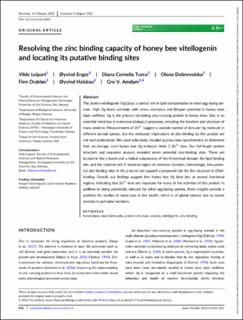| dc.contributor.author | Leipart, Vilde | |
| dc.contributor.author | Enger, Øyvind | |
| dc.contributor.author | Turcu, Diana Cornelia | |
| dc.contributor.author | Dobrovolska, Olena | |
| dc.contributor.author | Drabløs, Finn | |
| dc.contributor.author | Halskau, Øyvind | |
| dc.contributor.author | Amdam, Gro Vang | |
| dc.date.accessioned | 2022-12-22T08:24:32Z | |
| dc.date.available | 2022-12-22T08:24:32Z | |
| dc.date.created | 2022-09-13T12:44:44Z | |
| dc.date.issued | 2022 | |
| dc.identifier.issn | 0962-1075 | |
| dc.identifier.uri | https://hdl.handle.net/11250/3039162 | |
| dc.description.abstract | The protein vitellogenin (Vg) plays a central role in lipid transportation in most egg-laying animals. High Vg levels correlate with stress resistance and lifespan potential in honey bees (Apis mellifera). Vg is the primary circulating zinc-carrying protein in honey bees. Zinc is an essential metal ion in numerous biological processes, including the function and structure of many proteins. Measurements of Zn2+ suggest a variable number of ions per Vg molecule in different animal species, but the molecular implications of zinc-binding by this protein are not well-understood. We used inductively coupled plasma mass spectrometry to determine that, on average, each honey bee Vg molecule binds 3 Zn2+-ions. Our full-length protein structure and sequence analysis revealed seven potential zinc-binding sites. These are located in the β-barrel and α-helical subdomains of the N-terminal domain, the lipid binding site, and the cysteine-rich C-terminal region of unknown function. Interestingly, two potential zinc-binding sites in the β-barrel can support a proposed role for this structure in DNA-binding. Overall, our findings suggest that honey bee Vg bind zinc at several functional regions, indicating that Zn2+-ions are important for many of the activities of this protein. In addition to being potentially relevant for other egg-laying species, these insights provide a platform for studies of metal ions in bee health, which is of global interest due to recent declines in pollinator numbers. | en_US |
| dc.language.iso | eng | en_US |
| dc.publisher | Wiley | en_US |
| dc.rights | Navngivelse 4.0 Internasjonal | * |
| dc.rights.uri | http://creativecommons.org/licenses/by/4.0/deed.no | * |
| dc.title | Resolving the zinc binding capacity of honey bee vitellogenin and locating its putative binding sites | en_US |
| dc.type | Journal article | en_US |
| dc.type | Peer reviewed | en_US |
| dc.description.version | publishedVersion | en_US |
| dc.rights.holder | Copyright 2022 The Authors | en_US |
| cristin.ispublished | true | |
| cristin.fulltext | original | |
| cristin.qualitycode | 1 | |
| dc.identifier.doi | 10.1111/imb.12807 | |
| dc.identifier.cristin | 2051186 | |
| dc.source.journal | Insect Molecular Biology | en_US |
| dc.source.pagenumber | 810-820 | en_US |
| dc.identifier.citation | Insect Molecular Biology. 2022, 31 (6), 810-820. | en_US |
| dc.source.volume | 31 | en_US |
| dc.source.issue | 6 | en_US |

